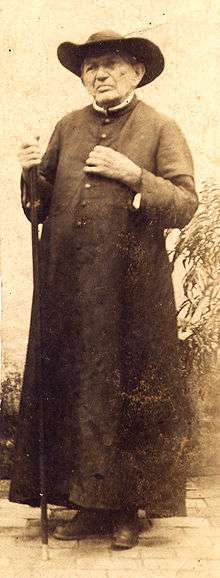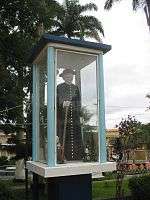Padre Cícero
| The Reverend Father Cícero Romão Batista ("Padre Cicero") | |
|---|---|
 Padre Cícero in 1924, aged 80 | |
| Orders | |
| Ordination | 30 November 1870 |
| Personal details | |
| Born |
March 24, 1844 Vila Real do Crato, Ceará, Empire of Brazil |
| Died |
July 20, 1934 (aged 90) Juazeiro do Norte, Ceará, United States of Brazil |
| Nationality |
|
| Denomination | Roman Catholic |
| Sainthood | |
| Venerated in |
Brazilian Catholic Apostolic Church Folk Catholicism |
| Canonized |
1973 by Brazilian Catholic Apostolic Church |
| Attributes | Black cassock and cappello romano, book, walking stick |
| Patronage | Juazeiro do Norte |
| Shrines | Capela do Socorro, Juazeiro do Norte, Ceará, Brazil |
Father Cícero Romão Batista, known as Padre Cícero (Crato, March 24, 1844 – Juazeiro do Norte, July 20, 1934), was a Brazilian Roman Catholic priest who became a spiritual leader to the people of Northeastern Brazil. In the course of his ministry, he was accused of heresy by Church officials, eventually becoming suspended but not formally excommunicated.
Batista has been declared a saint by the Brazilian Catholic Apostolic Church. He was listed in the Top 100 Greatest Brazilians of All Time in July 2012.[1] Reconciliation with the Roman Catholic Church happened in December 2015.
Biography
Batista was born in the Municipality of Crato, Ceará, in 1844, the son of Joaquim Romão Batista and Joaquina Vicência Romana. When he was six years old, he started to study under Rufino de Alcântara Montezuma. In his youth, he took a vow of chastity, made when he was twelve years old. This was influenced by his reading the life of St. Francis de Sales.
In 1860, Batista went to school in Cajazeiras, but because of the untimely death of his father in 1862, he had to return home to his mother and sisters. The death of his father, who was a small businessman in Crato, brought serious financial difficulties to his family.
Batista was ordained a priest on November 30, 1870. After his ordination he returned to Crato and taught Latin in the Colégio Padre Ibiapina, founded and directed by José Joaquim Teles Marrocos, his cousin and friend.
Juazeiro

For Christmas of 1871, invited by his teacher Simeão Correia de Macedo, Batista visited for the first time the small community of Juazeiro (which at the time was part of Crato) and celebrated the traditional Missa do galo (Mass at Dawn).
The visiting priest, who was 28 years old, short, white-skinned, light haired, and who had penetrating blue eyes, impressed the locals. And he was impressed by them. So after a few months, exactly on 11 April 1872, he was back in Juazeiro with his family and suitcases, to stay there as a permanent resident.
Many books state that Batista decided to stay in Juazeiro because of a dream or vision that he had. This supposed dream occurred after a long day of hearing confessions, when he looked for a room to rest in and fell asleep. According to his close friends, he saw Jesus Christ, and the twelve apostles sitting at a table, similar to Leonardo da Vinci's Last Supper. Suddenly, the place was full of poor Northeastern Brazilians. Christ, looking to the poor, said that he was upset with humanity, but that he was still willing to do the last sacrifice to save the world. But, if men didn't repent quickly, He was going to destroy everything at once. At that moment, he pointed to the poor and, said, "And you, Padre Cícero, take care of them!"
In 1889, when Maria de Araujo received Holy Communion from Batista, her mouth started to bleed. While the local people saw this as a miracle, Church authorities suspected other causes. The Holy Office in Rome charged him of heresy and mystification. His faculties to celebrate Mass and the sacraments were suspended in 1894, though he continued to celebrate Mass at his church. In 1898, he met with Pope Leo XIII in Rome, and he was granted a partial reprieve.
Apostleship
Batista initially started work on the small local chapel, getting different images with the offerings of the faithful. Afterwards, touched by the burning desire to win over the people that God confided into his care, he started intense preaching. He gave many counsels, and made many visits to homes, starting to exercise great leadership in the community. Also, he began to try to change the immoral customs of the people, personally getting rid of excessive drunkenness and prostitution.
With harmony restored, the community started to grow. Many people from neighboring communities were attracted by the new large chapel.
Politician
Batista was actively involved in the political of his time and was a member of the Conservative Republican Party of Brazil. When Juazeiro was raised to the status of a municipality, he was appointed its first mayor. He governed the city in this capacity for most of the next twenty years.
Death
Batista died on July 20, 1934, in Juazeiro do Norte, Brazil, at the age of 90. He was buried in the Church of Our Lady of Perpetual Help.
Legacy

Today, a large statue of Padre Cícero stands in Juazeiro do Norte, to which he is considered to be the patron saint of the city. A pilgrimage to this statue takes place in his honour every November, attracting hundreds of thousands of followers.
Batista was canonized by the Brazilian Catholic Apostolic Church, an Independent Catholic church. He is not recognized as a saint by the Catholic Church, though Pope Benedict XVI proposed a study on Padre Cícero as a candidate for canonization.[2]
On 13 December 2015, as part of the opening ceremonies of the Holy Year proclaimed by Pope Francis, the Bishop of Crato, Fernando Panico, M.S.C., declared the rehabilitation of Batista's status with the Roman Catholic Church. He further declared Cícero to have been a man of extraordinary virtues, formally reconciling him with the Church.[3]
References
- ↑ http://www.suapesquisa.com/pesquisa/padre_cicero.htm
- ↑ http://www.visitfortaleza.com/ceara/padre-cicero.html
- ↑ "Nação Romeira em festa: Igreja se reconcilia com Padre Cícero". Portal de Juazeiro. 13 December 2015.(Portuguese)
External links
- http://www.sfiec.org.br/noticias/padrecicero260704.htm
- http://www.cruzterrasanta.com.br/padre-cicero/#historia
- http://www.padrecicero.org.br/